国际商务英语模拟实训教程Unit17 Claim
全方位商务英语口语(第三版)Unit (17)
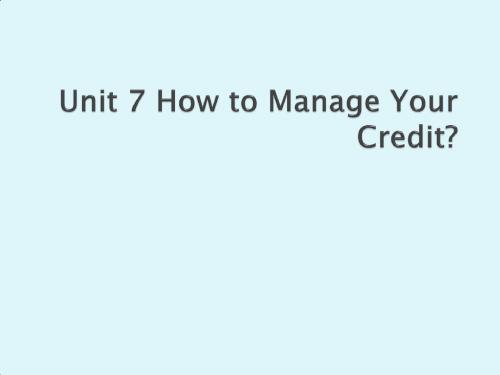
Work in pairs. Suppose you and your partner are a married couple. You have a joint checking account and both of you can write checks from it. Now create a checkbook with checks and a check register. Talk with your partner and make entries in the check register. For example, make up a phone bill, an electric bill and a rent bill. Pay them by check, enter the amounts in the register, and deduct the amounts from the balance. And try to figure out who bought what and argue about it. After all the groups have finished, you will report your checkbook account to the whole class.
Develop an introduction for the following situations.
You are introducing an exhibition center or a university gym or a university conference hall to a foreign guest. Following the above sample, develop an effective introduction. Try to provide as many details as possible. You are introducing a big national or international event, such as International Women’s Conference, Zhongguancun Computer Festival, Beijing Tourism Festival, etc. Provide as much information as possible.
国际商务英语模拟实训教程
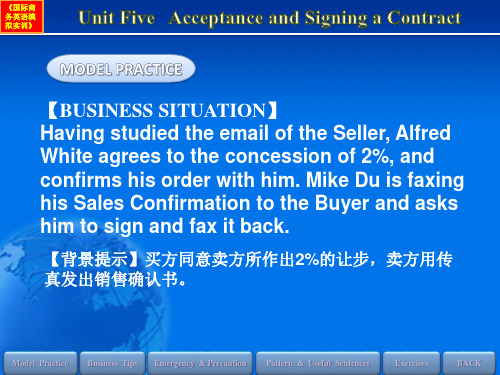
Exercises
BACK
《国际商 务英语模 拟实训》
3. We are pleased to place an order with you for 15000 pairs of women’s leather shoes.
很高兴向你方订购15000双女式皮鞋。
Model Practice Business Tips Emergency & Precaution Pattern & Useful Sentences
《国际商 务英语模 拟实训》
【BUSINESS SITUATION】 Having studied the email of the Seller, Alfred White agrees to the concession of 2%, and confirms his order with him. Mike Du is faxing his Sales Confirmation to the Buyer and asks him to sign and fax it back.
【背景提示】买方同意卖方所作出2%的让步,卖方用传 真发出销售确认书。
Model Practice Business Tips Emergency & Precaution Pattern & Useful Sentences
Exercises
BACK
《国际商 务英语模 拟实训》
Model Practice Business Tips Emergency & Precaution Pattern & Useful Sentences
Exercises
BACK
《国际商 务英语模 拟实训》
商务英语写作unit 17

Tห้องสมุดไป่ตู้sk Two:
After finishing Task one, you are to do a group work—find out how many parts the complaint and claim should include and what they are. Then check your findings with your teacher.
2. We have received ...(quantity/name/packing of commodities) on (date), but we found that the (quantity/quality/specification/packing) didn’t correspond to the stipulation in the contract. 我们已于…号收 到(数量/商品名称/包装商品),但是发现其(数量/质量/规格/ 包装)与合同规定不符。 3. We enclosed a list of items in Case #13. Please check it with our contract and send us the correct replacement ASAP. 我们随函附上 第13号箱子的货物清单。请将之与我们的合同核对,并请尽快 将正确的替代货品寄给我们。 4. We enclose the survey report and look forward to early settlement of the claim. 随函附上调查报告,期待贵方及早理赔。 5. We regret to notify/inform you that 10 pieces of the lighting fixture have been broken/ damaged severely. 很遗憾通知贵方有十盏灯已 严重损坏。 6. The goods are much inferior to the quality of our samples. 商品的质 量远次于我们样品的质量。
国际商务英语课文电子版lesson (17)
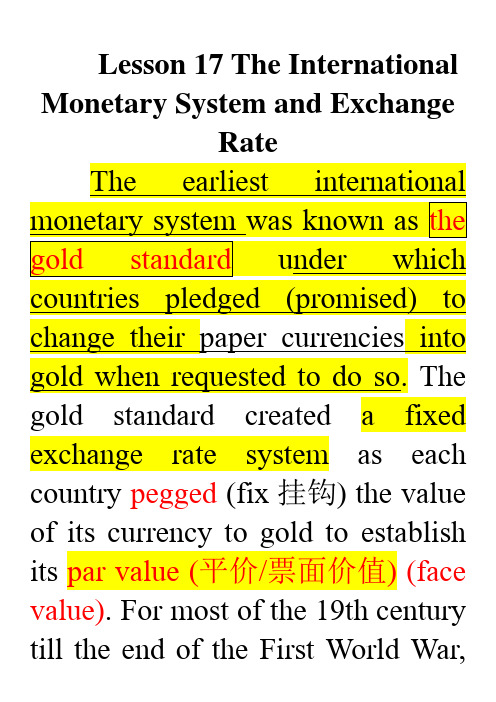
Lesson 17 The International Monetary System and ExchangeRateThe earliest internationalchange their paper currencies into gold when requested to do so. The gold standard created a fixed exchange rate system as each country pegged (fix挂钩) the value of its currency to gold to establish its par value (平价/票面价值) (face value). For most of the 19th century till the end of the First World War,major trading countries followed this system and the British Pound was the most important currency in international business as a result of the economic, political and military power of the United Kingdom, hence the term sterling-based gold standard. (pound sterling)The pressure caused by the First World War on economy coupled with(together with连同) the impact of the Great Depression (大萧条)put an end to(结束)the fixed exchange rate system. The Bank of England was no longer able to redeem (赎回,兑换)itspaper currency for gold at par value(以面值) (无力将其纸币以平价兑换成黄金) and allowed its value to be determined by supply and demand (market). With Britain abandoning (放弃)the gold standard, there appeared different areas in the world. Some countries pegged their currencies to the sterling(英镑), some countries to the US dollar and some to the French Franc, forming the “sterling area”, “dollar area” and “franc area”. This period witnessed the degeneration(衰落)of the international monetary system as some major countries vied(vie -compete)to(竞相)devaluate their currencies to make their export goods more competitive.(竞争性贬值) (这一时期,世界货币体系不断恶化,各主要贸易国家竞相将其货币贬值以提高他们出口物品的竞争力) The be nefits brought about by their devaluation were, needless to say (不用说), offset(抵消)by what their competitors did. International trade con t racted (shrink收缩) and economic conflict finally led to the Second World War.Towards the end of the Second World War (1944) representativesof 44 countries gathered at Bretton Woods (布雷顿森林)to renew(更新)the gold standard on a greatly modified basis(在修改较大的基础上). One important fruit of the conference is the creation (establishment创立) of the International Bank for Reconstruction and Development (IBRD)and the International Monetary Fund. (1944)The Bretton Woods Conference established a US dollar based gold standard. Because of the dominating (主导性的) economic and political influenceof the United States, the dollar replaced the sterling(英镑)as the major vehicle(工具)for international settlement(国际结算). 由于美国在国际经济、政治中的统治性影响,美元替代英镑成了国际结算中的主要工具。
高等职业技术学校国际商务单证实训手册
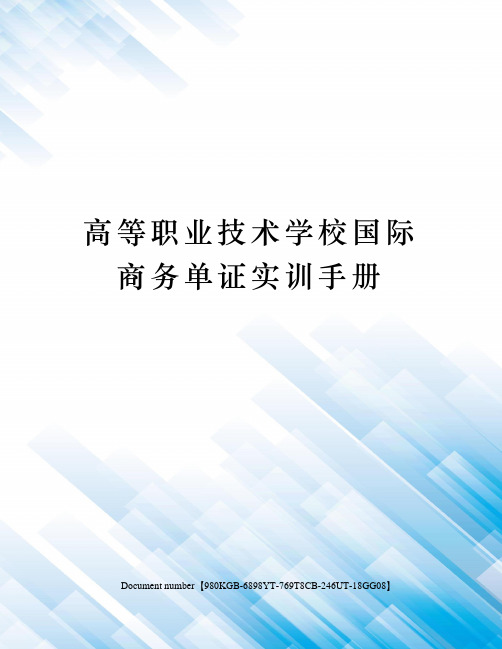
高等职业技术学校国际商务单证实训手册 Document number【980KGB-6898YT-769T8CB-246UT-18GG08】高等职业技术学校国际商务单证实训手册精品汇编资料编写说明国际商务单证制作实训是练习外贸各项业务单证的缮制方法和业务处理的技能训练课。
本课程设有合同、信用证、信用证的审核与修改、商业发票、装箱单、汇票、海运提单、一般原产地证/普惠制产地证明书、保险单、报检单、报关单、出口收汇核销单等实训内容。
通过实训,使学生熟悉进出口贸通过实训,使学生熟悉进出口贸易单证的种类、格式、内容和流转程序,掌握制单的基本方法,熟练、准确地缮制主要的业务单证和结汇单证,较好地处理其他流转单证,较熟练地掌握电脑制单技能,并能参加行业规定的相关技能证书的考试。
知识目标:1、了解外贸单证的业务流转。
2、理解外贸单证工作的基本要求。
3、掌握开证和审证、制单和审单的方法和要求。
能力目标:1、具有熟练的制单技能,能正确缮制主要外贸单证。
2、具有综合运用知识的能力,能较好地处理单证业务。
德育目标:1、培养认真、严谨的工作作风和团结协作的团队精神。
2、具有诚信、务实的良好职业道德。
3、培养开拓进取的思想意识。
目录第一部分单证制作任务一合同 (1)任务二信用证开证申请书 (6)任务三信用证 (12)任务四信用证的审核与修改 (17)任务五商业发票 (23)任务六装箱单 (27)任务七汇票 (30)任务八海运提单 (36)任务九报检单 (39)任务十报关单 (45)任务十一一般原产地证/普惠制产地证明书 (49)任务十二保险单 (56)任务十三出口收汇核销单 (60)第二部分全套单证制作任务一 T/T方式下全套出口结汇单据制作 (62)任务二托收方式下全套出口结汇单据制作 (64)任务三 L/C+FOB方式下全套出口结汇单据制作 (70)任务四 L/C+CFR方式下全套出口结汇单据制作 (73)任务五 L/C+CIF方式下全套出口结汇单据制作 (76)任务六国际商务单证员模拟测试 (79)第一部分单证制作任务一合同一、指导内容通过实训,学生熟悉合同的形式和内容,掌握合同各主要条款的制订。
国际商务英语口语实训Module 10 Complaints, Claims and Settlem
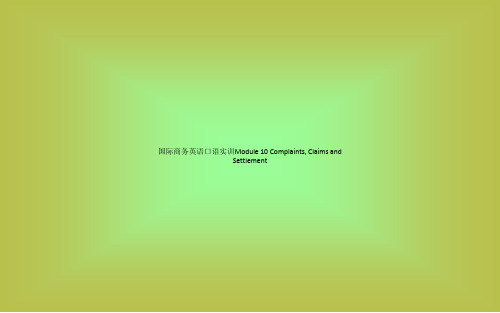
Module 10.1 Raising a Claim for Inferior Quality
Speaking out
unpacked for inspection by the surveyors. L: Have you discovered what the exact causes of the rusted bolt seals were? J: It’s quite evident that the rust resulted from poor workmanship. L: How many bolt seals are in this condition? J: Sixty cases of them. L: Just a minute, if you please, Mr. Johnson. It was rather a singular case, for thousands of tons of this product have been exported and it seems that they were damaged en route.
Module 10.1 Raising a Claim for Inferior Quality
Reading in
Relevant expressions for making a claim. It seems that they were damaged en route. It was definitely damaged prior to loading onto the S. S “East Wind”. This has made it necessary for us to file a claim against you. I’ll ask our manufacturers to look into the matte. I’m looking forward to your reply.
国际商务英语综合教程(全)

.stcudorp lles dna ereht tuo og nac I taht sevorp tsuj sihT .2
。"rof llew em deraperp evah"与"rof detius y ltcefrep leef"、"edam roliat"�是词键关眩人佳最是 己自示表�取争力努、调强要就作工的做欢喜且并�合适己自于对�虚谦分过该应不时绍介我自 .noitisop siht rof detius y ltcefrep leef I ,ecneirepxe krow dna dnuorgkcab ym htiW .2 .noitisop siht rof llew em deraperp evah ecneirepxe krow dna noitacude yM .3
。思意的’来未虑考、的瞩远瞻高‘有申引词容形
-------------------------------------------------------------------------------课二第�程教合综语英务商际国 我为因也时同 。法看的划计来未和前目于对位各听听能望希我 �步起刚才面方场市外海在 noitcA noitcA 责负将我 �的然自很 �以所 �的悉熟蛮还形情的带一那国美对 �位学士硕管企到拿国美在我 。厅餐的国美到具餐口出是的责负儿那在我。生陌不也司公个那对概大 位诸想我�作工司公品用具厨奇神在来原。表代务业外海的任新是我�吧己自说说的单简就想我 -------------------------------------------------------------------------------.ereh dnuora sepor eht gninrael m'I sa ,ecivda ruoy deen osla yam I .stcejorp erutuf dna tneserp -------------------------------------------------------------------------------译翻文中 。了许赞的您负辜要怕恐我�绍介的意好生先 nosbiG 谢谢 常市新的区会都大要主发开算打�军进部西中及部西向力主中集将们我。门部务业加美的 。教指多多位各要需还�段阶索摸于处正
剑桥商务英语》授课教案Unit 17

Unit 17 (a) Recruiting staffI. Teaching Objectives:i. To enable Ss to talk about recruitmentii. To practise reading and listening for gist and for specific informationiii. To focus on Conditional 2 for hypothetical situationsII. Materials needed: Cassette-Pass Cambridge BEC PreliminaryIII. Teaching Process:i.Unit overview·Recruitment methodsReading: Ss read an article about recruitment and complete a diagram, then look for the advantages and disadvantages of each method. Speaking: Ss discuss extracts from the article.Language focus: Ss review would and could/might for expected andpossible results of occupations.·Advertising a vacancyReading: Ss read two advertisements for the same job and answerquestions.Listening: Ss then listen to a conversation related to the job vacancy, decide which advert will be placed first and listen again for thedisadvantages of each of the two types of advertisement. Language focus: Ss identify the uses of the past simple verbs in the typescript then focus on Conditional 2.Speaking: Ss exchange ideas on how they would recruit people fortheir own jobs.·Self-studyV ocabulary: Sentence completion exercise (personal vocabulary). Language focus: Sentence completion (Conditional 2)Exam practice: Matching statements with graphs.ii.Detailed study of this unitStep 1 Recruitment methodsWarmer: T writs the title of the unit Recruitment staff on the blackboard and asks Ss what they think it means. T uses this to introduce the topic and elicit important vocabulary for the unit: to apply for, application, applicant,candidate, vacancy, to recruit, recruitment.Ex. 1 SpeakingT elicits from Ss how they were recruited to their present job. Ss then work in pairs to recruit staff (external or internal advertising, agency etc.).Useful expressions:1.External/ internal recruitment2.to use an agency3.apply for a job4.by advertising the vacancy in newspapers and magazines5.to recruit staff through the Internet6.interview / select the candidatesEx. 2 ReadingSs read the article and complete the diagram. Ss check their answers with a partner before general feedback.RecruitmentInternal externalMemo e-mail newsletter advertising directly agencyNewspapers commercialprofessional journals governmentInternetLocal nationalEx. 3 ReadingSs read the article to identify the advantages and disadvantages of each recruitment methods.Ex. 4 ReadingThe objective of this exercise is to stimulate discussion. T draws Ss’ attention to the use of could / might in the article in Ex. 4 to refer to the possible results of a hypothetical situation: which could cause personnel problems for the whole department / a rejected internal candidate might become unhappy andleave the company. T then refers Ss to the Don’t forget! section.Ex. 5 SpeakingSs discuss ways of advertising specific jobs. T encourages Ss to think of the advantages and disadvantages of any methods chosen.Step 2. Advertising a vacancyEx. 1 Reading.Ss read the two advertisements and answer the questions. They compare their answers with a partner before feedback.Note:1.package holidays: 团队(包价)旅游2.Travel industry / tourist industryEx. 2 ListeningSs predict which of the two advertisements they would place first before listening to compare their answers with what the managers decide.Ex. 3 ListeningSs may well be able to answer this question from their first listening. T Plays the tape again to check the answer.Ex. 4 GrammarSs work in pairs and find the verbs in the past simple form in the tapescript. Ss complete the Don’t forget! section.Ex. 5 SpeakingSs work in pairs to exchange ideas on how they would recruit people.Step 3 Self – studyHelp Ss finish Self-study exercises.Unit 17 (b) Applying for a jobI. Teaching Objectives:i. To enable Ss to talk about job applications and interviewsii. To practise reading and listening for specific informationiii. To practise writing a letter of applicationiv. To review indirect questionsII. Materials needed: Cassette-Pass Cambridge BEC PreliminaryIII. Teaching Process:i. Unit overview·Application lettersReading: Ss read an advertisement for a secretarial job and answer questions. Ss then order an applicant’s notes about theadvertisement.Language focus: Ss Match typical application letter language with thenotes.Writing: Ss work in pairs and write the applicant’s letter ofapplication.·Attending an interviewListening: Ss transform the interviewer’s notes into polite questions. They then listen to the interview and compare the questions used. Ss listen again and write down the applicant’s answers to the questions.Language focus: Ss review the form and use of indirect questions. Speaking: Ss ask and polite questions in pairs in order to fill in their partner’s application form. Ss then discuss how to answer four awkward interview questions and compare their ideas with those in Exercise 4 of Self-study.·Self-studyLanguage focus: Transformation exercise (indirect questions).V ocabulary: Word-field (qualities and skills).Language focus: Jumbled sentences (letter-writing).Exam practice: “Right, Wrong, Doesn’t say questions”.ii. Detailed study of this unitStep 1 Application lettersWarmer: T elicits what Ss normally expect to find in a good job advertisement. Ss then open their books and scan the Global TV advertisement to see if this information is included.Ex. 1 ReadingSs read the advertisement and answer the questions.Note: 1. O/T: overtime2. Wpm: words per minute3. MS Office experience :有办公文稿处理经验,MS = manuscript Ex. 2 ReadingSs then look at the applicant’s notes and discuss the correct order. In feedback there is a discussion. T asks Ss what they normally include in letters pf application.Ex. 3 ReadingAfter Ss have matched the phrases, T checks Ss are sure of their meaning as a full group activity.Ex. 4 WritingSs use the information provided to plan and write a letter of application. T points out the different pronunciation of a graduate / to graduate.Useful expressions:1.with reference to…2.I am writing with reference to your advertisement in…3.I am writing to apply for…4.I am a graduate of…, specializing in…5.Please find enclosed…6.I enclose my CV.7.be interested in the position because…8.I wish to apply for the pos ition because…9.I have had years of experience of dealing with…10.I have the skills you require.11.Looking forward to hearing from you.Suggested answer:PRODUCTION SECRETARYI am writing with reference to your advertisement for a Production Secretary in the Guardian of 23 July 2001.I graduated from Madrid University in 1994 with a degree in Modern European languages. My first full-time job was as a support secretary for the Training Director of a company which ran courses for software designers and IT managers. Since 1996 I have been working as a bilingual secretary for a large international publishing company.I am very interested in the position because I would like to use my languages.I am enthusiastic about working for a TV company and feel that I have the flexibility, motivation and communication skills you require.Please find enclosed my curriculum vitae and a photo.I look forward to hearing from you.In feedback T points out the different pronunciations of a graduate / to graduate.Step 2 Attending an interviewEx. 1 ListeningSs work in pairs to make polite questions from the handwritten notes. They listen to the cassette and compare their own questions with those in the interview. T focuses on the functions of polite questions. Note:Polite questions enable the speaker to be polite and relatively distant, as in a formal interview with strangers. Also indirect question questions can be used for potentially embarrassing or difficult information-gathering.Polite indirect questions are particularly useful when a new topic is being introduced but they are unlikely to be useful for follow-up questions. As long as the intonation is all right, direct questions can also be polite.Ex. 2 ListeningSs listen again and note down Almudena’s answers to the ques tion. They compare answers in pairs before general feedback.Ex. 3 GrammarSs answer the questions about the form of indirect questions.Ex. 4 SpeakingT does the first question with the whole class as a model before Ss work in pairs to complete their par tner’s form. To round off this activity, T wishes to go through the exercise, eliciting Ss’ questions at random. T should ensure that Ss do not only use indirect questions.Ex. 5 SpeakingT reminds Ss that indirect questions help people to ask for potentially difficult or sensitive information. Ss look at the four questions and make them indirect. T asks Ss to consider how they would answer such questions.Ss read the text from Ex. 4 of Self-study and compare their own answers with the advice in the text.Step 3 Self-studyHelp Ss finish Self-study exercises.Note:A letter of application is designed to ensure you to obtain an interview. It sells you to the employer, so it needs to be:1. Attractively presented to arouse the reader’s interest.2. Concise and easily read to save the time and trouble.3. Informative showing that your qualifications satisfy the requirements for the job vacancy.4. Properly modest.5. Tactful enough not to draw attention to your lack of experience in any respect.6. Persuasively inducing an action to get an invitation to an interview.7. In “you –attitude”8. In proper language and style.Supplementary Material for Future Use1.Samples of strong, positive openings●You are advertising for a… My experience in the fieldof…business …industry justifies me in asking you to consider me for the post of…●You wish to appoint someone to the post of…you will see from my datasheet that since I left the… all my employment has related to the field in which you operate.●My experience in the… industry / field of … will interest you inconnection with the vacant post of…●You are advertising for a… My resume will show you that I have …years’experience in the …field of...●You are advertising for a… If you will give me an interview , you will bec onfirm, I believe , that my experience in the… business…industry wouldbe an asset to your company.●Having a degree in electrical engineering and having just complete threeyears of employment in this field, I am writing to ask for an interview at which we could discuss the exact duties of the post advertised.2.Samples of closing paragraphs●I look forward to hearing from you and could be available for interviewat any time except 9th June, When I have examinations. I would very much like to work in a laboratory with such an excellent reputations for research.●I would be glad to supply any further information required, and hope tohear from you soon. I am available for an interview now.●My current salary is … boosted by free staff canteen for lunch andinterest-free season ticket loans. I would hope to match this, but could allow for a saving in fares by traveling less far. I look forward to hearing form you. I am keen to work for a leading manufacturer in the trade.●At present I am earning… plus 2.5 percent co mmission on paid-upsales invoices; there is an adjustable bonus for on-target earnings. A company car and medical insurance are also part of the package. I would expect to do as well for your company as I do in my current job and would be willing to show commission statements at interviews as proof of ability..。
国际商务单证模拟实训教程答案

《国际商务单证模拟实训教程》实训部分参考答案第二章商业发票实训答案:广东XXX 进出口公司GUANGDONG XXX IMPORT & EXPORT CORPORATION6TH FLOOR FOREIGN TRADE BUILDING ZHAN QIAN ROAD GUANGZHOU CHINAINVOICETO: ABC CORP.OF LONDON Invoice No.: 200699966/66A COMMERCIAL STR, Date: JUNE. 26, 2006LONDON S/C No.: 2006888From SHANGHAI, CHINA To LONDONL/C No. Issued by T/TMarks & Numbers Quantities & Description Unit Price AmountABC 300 CARTONS OF SCHOOL BAGSLONDON CIF LONDONC/No.1-300 ART. NO. QTY.AWT33 3600PCS USD 1.00/PC USD 3600.00AWT55 4800PCS USD 1.00/PC USD4800.00 ***********************************************************************************TOTAL: 8400PCS USD 8400.00SAY U.S.DOLLARS EIGHT THOUSAND AND FOUR HUNDRED ONLY.AS PER S/C NO. 2006888GUANGDONG XXX IMPORT& EXPORT CORPORATION公司经理签名或盖章装箱单实训答案:广东 XXX 进出口公司GUANGDONG XXX IMPORT & EXPORT CORPORATION 5TH FLOOR FOREIGN TRADE BUILDING ZHAN QIAN ROAD GUANGZHOU CHINAPACKING LIST. TO: ABC CORP. OF LONDON Number: 2006999 66/66A COMMERCIAL STR ., LONDON Date: JUNE. 26,2006MARKS & NOS . DESCRIPTION QUANTITY WEIGHT IN KILOSNET@ GROSS@ MEASUREMENT (CBM)ABC 300 CARTONS OFLONDON SCHOOL BAGSC/NO.1-300AWT33 100CTNS @ 3600PCS 26 28 40×30×50AWT55 200CTNS @ 4800PCS 27 29 40×30×40*********************************************************************************** TOTAL: 300CTNS 8400PCS 8000KGS 8600KGS 15.6M3AS PER S/C NO.2006888GUANGDONG XXX IMPORT& EXPORT CORPORATION公司经理签名或盖章提单实训答案: B/L NO.2006789 ShipperGUANGDONG XXX IMPORT &EXPORT CORPORA TIONFOREIGN TRADE BUILDINGGUANGZHOU, CHINA 中国对外贸易运输总公司CHINA NATIONAL FOREIGN TRADE TRANSPORTATION CORP.Consignee or order直运或转船提单TO ORDER OF SHIPPER BILL OF LADINGOFFreight and charges REGARDING TRANSHIPMENTINFORMATION PLEASE CONTACT FREIGHT PREPAIDEx. rate Prepaid at Freight payable at Place and date of issueGUANGZHOU CHINA MAY 16, 2006 Total Prepaid Number of original B/L Signed for on behalf of the MasterTHREE 船公司盖章as Agent(SINOTRANS STANDARD FORM 4) SUBJECT TO THE TERMS AND CONDITIONS ON BACK 95N NO. 0111678保险单实训答案:PICC中国人民保险公司广东省分公司The People’s Insurance Company of China, GUANGDONG Branch总公司设于北京一九四九年创立Head office: Beijing Established in 1949货物运输保险单CARGO TRANSPORTATION INSURANCE POLICY发票号(INVOICE NO.)2006JIE56 保单号次合同号(CONTRACT NO.)2006355 POLICY NO.NC1326信用证号(L/C NO.)被保险人:Insured: GUANGDONG XXX IMPORT&EXPORT CORPORATION 中国人民保险公司(以下简称本公司)根据被保险人的要求,由被保险人向本公司缴付约定的保险费,按照本保单承保险别和背面所载条款与上列特款承保下述货物运输保险,特立本保险单。
国际商务英语模拟实训教程课后练习参考答案

!"#$%&’(!"#$%"&’()&*+)+$#,",-()#.&/#0$!"#$%!"#$%&’%’(%()*+,-./01*-23,%’%’(&/))(+4/-5,-64$)$4’)$+(+,-./01*-7"!"#$%!!".’//+(%’(8(+%$-+3()/1%/9%’(9/1)&’/,&(+%/)(40$&(%’(1-5()0,-(54$)%""""%%!!!":)$-+0$%(%’(;-60,+’,-%/.’,-(+(/).’,-(+(,-%/;-60,+’<!&"#$%&’()*+,-./012345678"&9:;$%<=4531267>#?@AB4578#&5CDEFGHIJKABLM’NOPQR8$&STUVWX53YZ[\]#^_‘3#%’8&&5Cab3cdefghI#i j kXl12Zm’Dnopqrst’uv#&’3Y Z[\]Aw8x’&()*+*,,*-./0*/1+02+*,,0)*3221+4+*-5.6*+707).3)*-8-.6*’9).,*0)*:;<*-./0*/1+02 :;<0)*+7=*3221+4+*-5.6*+707,29*-8-.6*&(&>)*/0)*+*,,*-=7?*+0)*@.-+08-.6*,.+0’)*+)2;,1+;:=.07/280.=7,1*=7/1@2-).+*+0.A =70*2@0)*62/6*++.2/+)*92;,1:*62=8*,,*102=7?*./@752-2@0)*:;<*-&)&!*@2-*/*320.70./30)*8-.6*0*-=2@0)*62/0-760’0)*+*,,*-+)2;,167--<2;00)*@2,,29./3 62+07/7,<+.+02*/+;-**B82-0./3.=8-25*+8-2@.0+&*&C@’./0)*7:+*/6*2@20)*-+7,*+7,0*-/70.5*+’0)*62=87/<62;,1+*,,0).+!%8*-6*/07A :-271:<,29*-./30)**B82-08-.6*:*,290)*12=*+0.6+7,*+8-.6*’.0=.3)0:*7157/07A 3*2;+0212+2&!%&C0.+.=82-07/002.1*/0.@<7/1./6,;1*0)2+*2;0A2@A826?*062+0+0)70-*+;,01.-*60,<@-2= 0-<./302*B82-0787-0.6;,7-8-21;60&!"#$12,’3+4&0(),5,$#,"&’!"#$%&’%’(%()*+,-./01*-23,%’%’(&/))(+4/-5,-64$)$4’)$+(+,-./01*-7"%"!$#!J J!"#$%&’()*+,J!!"#$%%&’($’)’&(*+&,’-%.(%/($’/%.-0$%10’&(%-’23*0’($’.+4’-31+’42*-("!"#!!!!!"5-*+&3*(’($’6+731&$1+(%#$1+’&’%-#$1+’&’1+(%6+731&$8!$yz{|}~!"#s5$%&’(^G(6)*8"$+G,-.%3/0N1234’56789.:8#$;z<k=>?@A v BC^D8$$EF(G3)*HI’yz JKLM(z1N^OP,8%$QR,<=3^D1S?TU8&$%&’()*+,’-,,.-/01&/*&0(+2,31&)45-1(6&(015/5-718)532&*7&5.01&9(/8&0+)7:5,;,+<+2+0+&,5.5-/:/5*-’0,$’$=&()31+2&’3&,15-2*2+8&058)5345-/:2()05:-,101&,(2&5.5-/:/5*-’0,$ ($>’()(,,-/&45-3&1(6&,:(/&*)5&..5/0()*,:&)0?-+0&(,-95.95)&4+):-,1+)701& ,(2&,5.45-/:/5*-’0,$)$@1+,:/5*-’01(,<&&)(<&,0,&22&/.5/)&(/245)&4&(/$!*$#’’5/*+)70545-/&,0+9(0&’31(0+,01&9(A+9-9())-(20-/)56&/45-’5-2*.-2.+22V !"#$%&’(()*"+,#’-./00(’()*#)!"9*(0$($’(’-:&1+#%3.:+;,1($($’0%--’&2%+41+72*-*2$-*&’&1+#%3.:+<"!B#"C!!"9.3(123’0$%10’+0$%%&’($’)’&(*+&,’-(%/1331+’*0$%/($’)3*+=&"!##""!!!"5-*+&3*(’($’6+731&$1+(%#$1+’&’%-#$1+’&’1+(%6+731&$8!$yz,(z3WXYZ[\]8(^_y‘abc(z35C dV"$(^;yzX>F3AB’e r4fghijk%lml5dV#$kn yz34opq?3r’(z9:;stuvV$$#‘yzL w3x Z y"TU’yz-.;(z%D3uv8%$s#yz z{;(zX‘yz3>F5’yz|7;(}~uv8&$E&/&+,5-/!$>$F$:/+’&$@1&:/+’&+,7+6&)3+015-0&)7(7&9&)0$’$>,+0(.+/95..&/5/()5..&/,-<G&’00545-/.+)(2’5).+/9(0+5)V($H-/5..+’&+,.+/9.5/(3&&8./5905*(4$)$!5-2*45-&A0&)*45-/5..&/.5/01/&&*(4,05I-)&(01V!*$E&/&+,5-/:/+’&2+,0$#2201&:/+’&,+)01&2+,0(/&,-<G&’0055-/.+)(2’5).+/9(0+5)$!"#$%&’()*+(,+#"#",,$-$!"#$%&’%’(%()*+,-./01*-23,%’%’(&/))(+4/-5,-64$)$4’)$+(+,-./01*-7"!"#$%!!"#10%,40(&’/,&(+&’//+(%’(8(+%$-+3()%/9,00,-($&’/9%’(80$-:+"#$#"$!!!";)$-+0$%(%’(<-60,+’,-%/.’,-(+(/).’,-(+(,-%/<-60,+’=!&!nb "x #w 3$5%5&’’(6+$_)’*O \+’,(6L w 3-./0mb 13238"&DE ,6+$3_)4B6Y 5363?’7’89,6%g+P?3_)8#&,63:b ;_)’{,B6JK,6<+$>?633_)’=’,>?@0*3AB P4C18$&(6L w 3-.DE/0’FG ^H $_)63‘8%&D k0b 6k b 1#w m+$>IA1’J @K G;,6k LM 8&&()*+*,-..*/01.**02)+-3*453*4*67-/*4)*25/3-4-5/0.80.9*:56*02)594257*0/345*+;4-704*4)*<65101-.-4=5:+922*++&’&>/70?-/@4)*/*A4758**02)<064=B+25/2*6/-+,-4)4)*3*@6**5:2577-47*/4)*0440;2)*+450/=-++9*&(&()*756*-7<5640/44)*3*2-+-5/’4)*@6*04*64)*<6*++96*,)-2)4)*-7<5+-4-5/5:04-7*.-7-4+26*04*+N 4)*+)564*64)*4-7*0..5,*3454)*/*@54-0456’4)*@6*04*64)*<6*++96*45,)-2))*-++91C*24*3&)&()*<962)0+*63*.-1*604*.=*A4*/3+4)*/*@54-04-5/++54)044)*+9<<.-*6-+.*:49/2*640-/0;1594)-+6*0.-/4*/4-5/+&!*&()*D064=B+-/-4-0.3*70/3,0+5<4-70.-/6*.04-5/45)-+*A<*2404-5/5:4)*E<<5/*/4B+25/2*++-5/:024560/35:)-+5,/25/2*++-5/:02456/*2*++06=45+*296*4)*25/2*++-5/:6574)*E<<5/*/4&!"#$%#-.)/00.1$+"0.+"23#,"#",+4&"$(+0$./01234!"#$%&’%’(%()*+,-./01*-23,%’%’(&/))(+4/-5,-64$)$4’)$+(+,-./01*-7""%$!#!F -./01234F +!U U!"#$%&’()*+,U!!"#$%&’(%)*+,’*)-+*+,,-)&+).)-&/0-1)2&,3’%%’0&+).%/04-"!""!#!!!"52/0-%/&)&+)607%’-+’0&,8+’0)-),28+’0)-)’0&,607%’-+"!$+-OP3R OP+QR y ST1b6UV8"$y6W N9X7!Y m Z[\]v%&"^_‘a8#$b y S’c K d n yz b e3V f8$$^_y Sg^_J h!Q i b jkla M lm’F Q i b no1la’!no1la s&=1S’J11S8%$^_y Sg^_J h!9:HIc1pq V m’b q+r6st’b q+u6st8 &$’()*)++),-./!01),-2,))3454.5+0/)3()64++478.23,-.9-5384.-554,/8.2343():)+473),;9-./54./8384.9i’$<64.)=-,316-8+93460+68+3()54.3,-53’3()43(),=-,3189).383+)/345-.5)+83$($>);093(-?)140,%&"-3+)-93#)/-19:)64,)3()38;)469(8=;).3$*$’()-,:83,-384.9(40+/:)68.-+-./:8./8.20=4.:43(=-,38)9$!)$@0-.3831-++47-.5)89-39)++),A94=384.$!9":2’&’07+;<=6;8>?5@<85"4.3,-53BC i<D!)"%E-3)i C35$"%’"))&’()!01),9i FD’"G’G#<D%D"’H<"#%#II%<#B"D*"CFI#BJ’$%+’F#<’H<"G<’H HC#E$’!#BKLCL’’#<%#BE’()*)++),9i KM#BKNGCM<FICH’#BE DOICH’"CHICH#’<CB’BC$%(’NG#B@<#B HC#E’KM#BKNGCM’"G<B#’()!01),9-2,))34:01-./3()*)++),9-2,))349)++3()64++478.2244/94.3),;9-./ 54./8384.9-99)364,3(:)+47iv!w B-;)46"4;;4/831’*=)58685-384.9-./I-5P8.2i’Q*D’G<*DB*Dv"w@0-.3831i"))9)39v#w M.83I,85)i"<R"))M*Ev$w’43-+Q-+0)i$)’)))M*Ev*(8=;).3@0-.3831%S;4,)4,+)99-++47)/wv%w’8;)46*(8=;).3i E)5$"./’"))&v&w I4,346+4-/8.2i K0-.2T(40v’w I4,346E)938.-384.i!-.2P4Pv(w<.90,-.5)i"4?),8.2>$I$#34:))66)53)/:13()9)++),$v !w !"#$%&’()*$"+,i -*.&+’/#$"0’/##"1&.)23"3",,"#&’.#"0/,/+’)1&4#&’,5"%"33"#6)*)23"),%/75,+&,)33&8/+76)#,/)3%5/6$"+,)+0,#)+%%5/6$"+,9!5":",,"#&’;#"0/,$4%,#").5,5"<"33"#%2"’&#""#0)*%9<"33"#%v %/7+),4#"w i $$$$$$-4*"#%v %/7+),4#"w i !"#$%#&’!()#")*+,-.$/01#.234"$/"56/734"$%4$$1434"$56*78!"#$%&’%’(%()*+,-./01*-23,%’%’(&/))(+4/-5,-6.’,-(+(%)$-+0$%,/-+,-./01*-7"=>-?;!!"#10%,40(&’/,&(+i &’//+(%’(8(+%$-+3()%/9,00,-%’(80$-:+"==;-=!!!";)$-+0$%(%’(<-60,+’,-%/.’,-(+(/).’,-(+(,-%/<-60,+’"%9yz z{xyz{|b &}\]C $1g ~^K !"’K !"#‘"’&##&$8’9yz %C $3K !"Q &’6()#‘’F Q &f *+e r g !8"9y C QR P ^,->#./3f *lm 8(9yz z{C $K !"p"011‘’yz W NO |’6~#g 23$.8&9yz S 45’1^P ’6k0k %%0q H 6$.’s#78’69%3:;<=k :"0T ’#>?@C A 8)9@+.)%",5")$"+0$"+,&’:A ;’/,/%+"."%%)#*,5),,5"%,/643),/&+%/+:A ;%5&4302"/+"B).,)..�)+."8/,5,5"<)3"%;&+’/#$),/&+9*9C&430*&463")%","334%85),"B).,3*/+%4#)+.".&1"#%)..�/+7,&*&4#4%4)3;9@9D,"#$%V+9?’,"##"1/"8/+7,5":A ;’8"’/+0,5),,#)+%%5/6$"+,)+06)#,/)3%5/6$"+,)#"+&,)33&8"09!9>+.3&%"0/+,5/%3",,"#)#"#"3"1)+,0&.4$"+,%’&#*&4#.5".E/+7)+0,)E/+7,5"0"3/1"#*9%#9(3")%"’)B ,5"<)3"%;&+’/#$),/&+,&4%%&,5),8".)+)##)+7",5"%5/6$"+,8/,5&4,0"F3)*9!=">),%,-6i=")#G#9H&5+<$/,5’C/,5#"’"#"+.",&,5"&’###$&4+,)/+""#/+7I).E",%4+0"#&4#<)3"%;&+’/#$),/&+J&9&&#’8"K03/E",&5)1"*&4#),,"+,/&+,&,5"’).,,5),,5"0),"&’0"3/1"#*/%)66#&).5/+7’24,,/33+&88"5)1"+&,#"."/1"0*&4#:",,"#&’;#"0/,9(3")%""B6"0/,"/,%"%,)23/%5$"+,2"’&#",5""+0&’,5/%<"6,"$2"#’%&,5),8"$)*.&+%/7+*&4#0"$)+0"07&&0%)%%.5"043"09!L -./01234L $!K K!"#$%&’()*+,K!"#$%&$’#()#*%+,-+&.,&"’(/&"%/&"’+’01&(+&/(2&+,$&’3(’’3&456+’*0,1(’*#"+ ($&*"&7(8’(88#$%("8&9*’3’3&’&$/+#:’3&8#"’$(8’;<&1##2:#$9($%’#$&8&*)*"=>#,$:()#$(-1&$&+0#"+&(’("&($1>%(’&;?#,$+:(*’3:,11>’@3("=A,*’B(1&+/("(=&$’A&’(*C($/&"’+!"#$%&’&"()*$+,-#*.#"/0129:;<6!"#$%&’%’(%()*+,-./01*-23,%’%’(&/))(+4/-5,-6.’,-(+(%)$-+0$%,/-+,-./01*-7"D E F G6!!"#10%,40(&’/,&(+i&’//+(%’(8(+%$-+3()%/9,00,-%’(80$-:+"E6D E6!!!";)$-+0$%(%’(<-60,+’,-%/.’,-(+(/).’,-(+(,-%/<-60,+’"!;yzN EFy Sla=7GC$K!"8";=(6#0!$B3C K~yz O|K!"z{C0’DEF3n yz%|1G m\ ]39|8%;yz k0(60H M C"]IJ!m K H’LM|y6S K!"$N‘OPQR8 &;STM|(6’yz UVWX b q T Gv c pq^_J h!3YZ K!"3[\m’S K!"&0"&B C0’]>##’%8(;K!"N+~!\]H^_]e‘’S\]N a(6[),‘()%C#‘8’;H1&(+&"#’&’3(’0(>/&"’*+’#-&/(%&->8#":*$/&%’*$$&)#8(-1&456(11#9*"=0($’*(1 +3*0/&"’+("%’$("++3*0/&"’’0(>(-1&->%$(:’(’+*=3’;#;<&+3(11-&=1(%’#+3*0’3&=##%+->(%*$&8’+’&(/&$’#I("8#,)&$9*’3*"%$%(>+(:’&$ $&8&*0’#:>#,456;);?#,$456/,+’$&(83,+#"#$-&:#$&’3&"(’3#:’3*+/#"’3’#’3&$9*+&9&+3(11"#’-&(J -1&’#8(’83+;+;j D#"=:&"=x;*;H1&(+&"#’&’3(’’3&45681(,+&+/,+’-&*"+’$*8’(88#$%("8&9*’3’3&+’*0,1(’*#"+#:’3& B56;!$;!3#0&’#$&/*"%>#,’3(’>#,+3#,1%"#’*"+&$’*">#,$456(">81(,+&+’3(’($&"#’(J =$&&%,0#";!="2-+3()%’(>1(+%,/-8),(90?"K!"3C02b iv !w ru(6c ^_lm d A b P v !"#$$%$&’w i v !w e 1v K !""#f ‘g ’’v (w x1b h 9|]v 9:n u 6\]w ’v )w i 9%k03Z F 8v "w r 6jk G \]v C "]w 6$l 5’C 0k0u 6m ]K !"~i $3no l a M lm L "#-+p 3K !"8v #w C "]N K !"W w;K !"~x139|]8v $w 9|]9|K !"3-+p ’H u 68!"#$%#&’$()*+,-."/-."$=>;<6!"#$%&’%’(%()*+,-./01*-23,%’%’(&/))(+4/-5,-6.’,-(+(%)$-+0$%,/-+,-./01*-7"*+,-.!!"#10%,40(&’/,&(+i &’//+(%’(8(+%$-+3()%/9,00,-%’(80$-:+"-.,,+!!!";)$-+0$%(%’(<-60,+’,-%/.’,-(+(/).’,-(+(,-%/<-60,+’"!/5qr (6K !"D c iv !w pq P S##%%s 8v "w t G u<8"/DE(6^k K !"~t G _v Rf,yz (6{1,I 8#/DE(6^e "w 1xy G qr K !"yzN z :{\’s#.%z{.,|fSx#w‘8$/yz z{}~k !w <%"43y Sla ,K !"#]‘qr 8&/HI c n !$’y6S oN K !"H e 13j Rf 9i !%x r #j Rf 9i H ^x 8’/012#34,#$!)5$6278$7’$#6!8’(2’1&$9!%:&!’:1&’;$<:&6’5!’’5$!%12&’1<’5$)#$6=:’:7>$77’5!&’5!’1<’5$)1&’#!)’/?>$!7$!%$&6812#34,’1:&)#$!7$’5$!%12&’/(/.7’5$#$:7&16:#$)’7!:>:&"<#1%@2!&"A512’1812#B1#’&$9’%1&’5’812!#$C:&6>8!7C$6’1!%$&6’5$75:BB:&")>!27$71<812#34,’1#$!6j ’#!&775:B%$&’!>>1;$6x)/D$75!>>(11C 75:BB:&"7B!)$1&’5!’E$77$>2B1&v 1&w #$)$:B’1<812#34,!%$&6%$&’/*/F’:7:%B$#!’:E$<1#812’1!%$&6’5$34,!7B$#12#<!91<’5$"&’5/!%/.7#$G2$7’$6’;$5!E$%!6$71%$!%$&6%$&’7’1’5$’$#%71<’5$34,/!="2-+3()%’(>1(+%,/-8),(90?"K !"3r"2b iv !wu 6k0r 6,K !""$qr 8u 6gvv &r ’(W g k )*&K 6_($qr 508!H -./01234H +!A A!"#$%&’()*+,Av!w DE r6S o‘u6350’;T xy C"\]C$qr!8v"w C"],K!"qr+’N qr!9|;9|]8v#w9|]N qr9|;u68!"#$%#"&’()*+#",?@!"#$%&’%’(%()*+,-./01*-23,%’%’(&/))(+4/-5,-6.’,-(+(%)$-+0$%,/-+,-./01*-7"!"#$%!!"#10%,40(&’/,&(+i&’//+(%’(8(+%$-+3()%/9,00,-%’(80$-:+""!%%!"!!!";)$-+0$%(%’(<-60,+’,-%/.’,-(+(/).’,-(+(,-%/<-60,+’"$&gv;y b n’TU>,3&=5Ce-h g.b n1T89/0dV!&c yz%|’STU1d S,’/#2.348"&H,kn p~5673HIc’&(!8gv9:!#0#;G&K8#&b<G m(6K!"’y6N==234>Rf8%&e r Z?S>;Rf Z"’k@‘L+N+\]W;(68&&’()*+,-./012-,+341)5+.+1+.6+7’28+-1+1+9741)*+9+,+11-.:-228;,-);09(0.31&’&<.-9120.)5:1+-;1)*+301);320.)-9)307+0().-9120.)-);09;9)*+=0.87)07-:& (&>0.14,*-5;/0.7+.’=+2.0201+)0*-6+)*+/00717;12-),*+75:1+-&)&?;9,+)*+.+;1907;.+,)6+11+8’=+*-6+)0-..-9/+348);307-8,035;9+7).-9120.)5:.-;8 -971+-&$*&@+*-6+-..-9/+7)0).-9120.))*+.;,+:0424.,*-1+75:.-;8&!"#$-&"’.//+#",01#22#",02)*&4A!"#$%&’%’(%()*+,-./01*-23,%’%’(&/))(+4/-5,-6.’,-(+(%)$-+0$%,/-+,-./01*-7"%"$#!!!"#10%,40(&’/,&(+i&’//+(%’(8(+%$-+3()%/9,00,-%’(80$-:+"!$$%"!!!";)$-+0$%(%’(<-60,+’,-%/.’,-(+(/).’,-(+(,-%/<-60,+’"$&QR3T A n BC8!&DEFG1HIJ0v K.%-M8!!p z 1LM ,!!N QR 8"!-D C O ’,!‘PQ 3QR R08#!67QR )*BS’BC’BT’BU 8$!"#$%$&’()*+,#(-)’.)/0-1*+23*’.%)’04&’(0/&!%!5#(%0446’/0-1*+2-.0(2)*&*+-4$7)7*+’.)-#+’(0-’/(*-)!&!8.*(’&0()’#9)/0-1)7*+/40&’*-:4*+)730’)(:/(##,-0(’#+&!’!;0-1*+2-.0(2)*&09#$’!<#,’.)’#’04-#&’#,’.)2##7&!()!=)-0++#’0,,#(7’*%)’#-.0+2)’.)/0-1*+29)-0$&)’.)&.*/3*44&0*4*+’3#706&!!"#$%&’(’")*+,,+-#$./"01’2$#+"BC!"#$%&’%’(%()*+,-./01*-23,%’%’(&/))(+4/-5,-6.’,-(+(%)$-+0$%,/-+,-./01*-7">?@A B!!"#10%,40(&’/,&(+i &’//+(%’(8(+%$-+3()%/9,00,-%’(80$-:+"@A B >A!!!";)$-+0$%(%’(<-60,+’,-%/.’,-(+(/).’,-(+(,-%/<-60,+’"(!yz3&=k d m f-+’&VWXY v Z ]8*![(N \q M C g pq ]y S 1^#’r 61_j u 6‘U ’L 6a {u 6S o3T <6b $n 3Vc X M 8!!y S e 1y6’H r 6’1_d G ke39eV 1y C3.%’yz S EF 9|(6yz 1O1fg .%’g !+(6hi 8"!Vc +~!&=VcVjWk ]8S WVc T <’k !@H l -m d 8#!+e39T <]$n 31T "!"93=\M b qn I W 38$!@,’)(()*+&/)-’*#+0’/#(’#,7)&’*+0’*#+’’.)D$04*’6#,’.)2##7&30&,#$+7+#’*+-#+:,#(%*’63*’.’.)-#+’(0-’&’*/$40’*#+&!%!E/#+)F0%*+*+2’.)2##7&’3)7*&-#G)()7’##$(&$(/(*&)’.0’’.)63)()04’#2)’.)(*+,)(*:#(*+D$04*’6’#’.)&0%/4)&#+3.*-.90&*&3)/40-)7’.)#(7)(!&!H.)9$6)(&0())+’*’4)7’#()*+&/)-’’.)2##7&$/#+0((*G04)G)+’.#$2.*+&/)-’*#+.0&9))+%07)#,’.)2##7&9),#()&.*/%)+’!’!=),))4’.0’’.)D$04*’6-)(’*,*-0’)&*&&$)7966#$(*+&/)-’*#+9$()0$0()+#’)+’*()46’($&’:3#(’.6!()!=)I440--)/’’.)2##7&#+46*,’.)()&$4’&,(#%’.)’3#*+&/)-’*#+&-#*+-*7)3*’.)0-.#’.)(!!J -./01234J +!"D D!"#$%&’()*+,D!"#$%&’()’*+,-$./-0’1(232$#."#D!"#$%&’%’(%()*+,-./01*-23,%’%’(&/))(+4/-5,-6.’,-(+(%)$-+0$%,/-+,-./01*-7"!"#$%!!"#10%,40(&’/,&(+i&’//+(%’(8(+%$-+3()%/9,00,-%’(80$-:+"""$%$!!!";)$-+0$%(%’(<-60,+’,-%/.’,-(+(/).’,-(+(,-%/<-60,+’"!&yzkp no"~p!‘!@H39!+78"&#%3qr%<=3Z]’P v Vc"9!#a"8#&s R.%=1{X^T Vc+’X^Y v tu8$&!h k,p C Z%l M^T}vw~3G xy0^T8%&yz nEF z{)*3]H C|}5C38&&’()*+,-./0-123405+)670218/69,1,)8:(055;)1,:269805!<=/91>)02*,()*+,-./0-123 405+)6702)?/69,1,)8:(055;)1,:=@$/91>)’812+:,())?/69,*+,-&’&’()366*:>0226,;):(1//)*0:,()>62:132))12,():,9013(,;1556750*1231:12>62:1:,)2, A1,(,()69131205>62,90>,&(&’0917790,):6218/69,:705512,6,A6>0,)3691):i3)2)90590,):02*/9)7)9)2,10590,):&)&’()!+:,68:405+0,1626718/69,02*)?/69,366*::(055;)*),)9812)*;-,()!+:,68:62 ,();0:1:67,(),902:0>,162405+)67,()366*:&!*&<8/69,)*02*)?/69,)*>0936’)?>)/,A()9):/)>1055-)?)8/,)*’1::+;B)>,,6,()2)>):.:09-!+:,68:)?08120,162&!"#$%4#3$’’"*5"-,32"1’EF!"#$%&’%’(%()*+,-./01*-23,%’%’(&/))(+4/-5,-6.’,-(+(%)$-+0$%,/-+,-./01*-7"!%$#"!!"#10%,40(&’/,&(+i&’//+(%’(8(+%$-+3()%/9,00,-%’(80$-:+"!"!%$!!!";)$-+0$%(%’(<-60,+’,-%/.’,-(+(/).’,-(+(,-%/<-60,+’"!+T G e r’}()#‘!!*C~em e39!8"+e r g]U e r"Y’1’D*3e>;r#’‘p e r g+r6f‘8!"yz z :45n7}r 6k0}()#‘#$%!~e ’syz y S e 1=^}()#‘3##%!~e 8&"DE e rTU S o’g ~eb $rM %&rvp3>;r’‘p3e r #‘*+r 6,’8$"e r gkEF ~e &=3k \’~e 3"Y 23Me3931S ’18’""#$%&’’(#)*+,-%#.(#/0*/-121**.1+-%#(#3#0.-1)21*(,#40-+1-#5("6’#&$#0+$*(#-%#$%0./#+--1*$"67&+,&8&0+$-"&(90$:5)";%#.(#/0*/)1(<(#&:&8#0$*!’0)21*=1*’,’0:#-10+$*(#&8&0+$-0-’=#=0’’#))#3-0-)1(21*(&331*+-5+"6’#&$#0+)1(/*$0);6>?0$0+3’*,#,0+21*(.(03#5#%"6’#&$#@*1-#*$21*(’1=#$-A67(&-#)1(B )’%%%1+;C $#-$)(1/D1+8:1+8-1E%&+8F%&05!"#$%&’($))"*+,#-.)"$/+,#--#"0123#4)@G*@HIJ!"#$%&’%’(%()*+,-./01*-23,%’%’(&/))(+4/-5,-64$)$4’)$+(+,-./01*-7"<?7G H!!"#10%,40(&’/,&(+i &’//+(%’(8(+%$-+3()%/9,00,-%’(80$-:+"7<7<H!!!";)$-+0$%(%’(<-60,+’,-%/.’,-(+(/).’,-(+(,-%/<-60,+’"#"DE .%k f *(~w )w9o n ’!T n j *f x 8*"=H ^m +93fg+’6h ’8!".b (f ’yz cW ;(6b ,Z F -B8&"+G |1.d<=’yz =,23^/*f 8$"!N *f 6_.%0M 1O ’F :2Z8’""#%1.#-%#811,$3&+4#,#’0I#(#,4#)1(#E#.-#/4#(5(""#%&I#4##+0+)1(/#,42-%#’13&’3&(81’0+#$-%&--%#)(#08%-j J0+8x 0$’#&I0+8)1(K&+3%#$-#(1+$0L-%+#L-/1+-%5)"6’#&$#&,I0$#*$#%,&2$4#)1(#-%#/1+-%1)$%0./#+-1)31+-(&3-+*/4#(’+&/#1)31/F/1,0-2’@*&+-0-2’.1(-1)’1&,0+8&+,-%#-0/#=%#+-%#811,$(#&3%-%#.1(-1)’1&,0+85+"M1*&(#(#@*#$-#,-1&3-&331(,0+8-1-%#4*2#(N$$%0..0+80+$-(*3-01+$0+1(,#(-181-%(1*8%-%#3*$-1/$$/11-%’25#%";%#811,$&(#4&,’2+##,#,56’#&$##L.#,0-#$%0./#+-5!!O -./01234O ,!"@@!"#$%&’()*+,@!"#$%#&$’’"()*’+,*#"-,"./0,1#"#"-23451’"$6KL*MN%6!"#$%&’%’(%()*+,-./01*-23,%’%’(&/))(+4/-5,-64$)$4’)$+(+,-./01*-7"!"#$%!!"#10%,40(&’/,&(+i&’//+(%’(8(+%$-+3()%/9,00,-%’(80$-:+"%"$#%!!!";)$-+0$%(%’(<-60,+’,-%/.’,-(+(/).’,-(+(,-%/<-60,+’"!&K!"1T Z F~0M$N3431i6Z’&}()’e r Z M\q Vc!8"&8C]gv v=5|15v!$+w1e s G,Z F#]‘a8#&DE r6g C"]s Z F t k1^x’d6‘a’-+p)*NB#’\7’8#v+ >;g!b9:%\]8$&9|]g e‘]gv d6;-Z F L N!n Z F f%-+p v Tqr g;)<3Z F8%&=>b?@A3la e1’\]|15v#b),Z F#]BC8&&’()*+,)-+(.)*/0)*+1/234+(),’)*+536+-27((/8)79+:/,,+,,;/(/0)*+.//1,7(1 :-/2++18;)*)*+;4:/-)0/-47<;);+,&’&=*+67-+(/);(7:/,;);/()/>+-;068*+)*+-)*+.//1,,3::<;+17-+72)37<<6;1+();27<8;)* )*/,+,:+2;0;+1;()*+2-+1;)&(&=*+67-+/(<62/(2+-(+18;)*8*+)*+-)*+1/234+(),:-+,+()+17-+;(2/(0/-4;)68;)*)*+ )+-4,7(12/(1;);/(,/0)*+2-+1;)/-(/)&)&"03-)*+--+7,/(0/-27-+;(1-78;(.3:)*+2-+1;))+-4,;,)*7))*+2-+1;);,<+.7<<6?3;)+ ;(1+:+(1+()/0)*+3(1+-<6;(.)-7(,72);/(&!*&$7(9,1+7<;(1/234+(),7(1(/).//1,&!"#$7#0$’’"(23451’"$68’95#*’.:;<=>;<6OPQR%S!"#$%&’%’(%()*+,-./01*-23,%’%’(&/))(+4/-5,-64$)$4’)$+(+,-./01*-7"%!#"$!!"#10%,40(&’/,&(+i&’//+(%’(8(+%$-+3()%/9,00,-%’(80$-:+""$%#%!!!"#$%&’(%)*)+*,&-(.’+.&)/0+.&*’*/$0+.&*’*.&)/,&-(.’+"!!e r Z ne r&M ~e p L w 3e r y S 8"!^f Z 3D ^EF G <e 6Z ’=n G 1g u _’s -1n%_Z F 8#!.%m d e3G v +’=/c "G .p 3H q T gvw .8$!I <y T 6Z n+<=3,I p C ;$%&36Z 8%!&}()n J I ru(6KL w M 3b N jk 3MN Z F 8&!"#$%&’’$(%)*+),-&)%$).*/&%0’$,12)-),2/$1*)+.&32&&/.’.$(-)%$’4()%$’50*,1)16’.$11+$’$,11$(’.*,/.#)4’$,1!’!7*,8.*($*01#&()9$/1&*%%$41:#*1$-$(/&%0’$,1.*($4($.$,1$/’4(&-)/$/1#*11#$6*4;4$*(&,1#$3*%$1&<$),%&’4+)*,%$:)1#1#$%($/)1*,/:$($,&1)..0$/<61#$.$++$(v <$,$3)%)*(6w !(!=0%#*<)++).0.0*++6’*(8$/.0<>$%11&%#*(1$(4*(16’1#$($3&($)1).,&10.0*++6%&,.)/$($/1&<$/&%0’$,1&31)1+$!)!"#$),.0(*,%$4$()&/.#*++<$+)’)1$/1&)*/*6.04&,/).%#*(2$&31#$),.0($/%*(2&3(&’1#$4+*,!!*!?3*//)1)&,*+),.0(*,%$%&-$(*2$).,$$/$/’1#$$@1(*4($’)0’.#&0+/<$3&(1#$<06$(A.*%%&0,1!!"#$%&’&"$&&"()*+#,TU!"1%)2+)+*)*$3’.&0/(43&56.)+)+*2/$$*’7/&8.&-0+.&*’*)$%&’(%)./&’.&0/(43&9"7B C D E!!"14().7(*2+/.2*’i 2+//’*)+*:*’)%&’6*$)/;.((.&)+*:(%&<’"C B C C B!!!"#$%&’(%)*)+*,&-(.’+.&)/0+.&*’*/$0+.&*’*.&)/,&-(.’+"!!D k J @o 2Ke~’O G ‘U "P 3o "=k Q C 8@D o 2""’c n ‘U ~3b "b k m 08"!FG (=z ;m 9|’>+b v &*D R E R R S b 8#!{TU Vj %VWXY V C ’h #m R 3Z =1[gv a p z Z !8$!\<m d ]^#’yz (N >~1%*F ?@n _3’,-yz [m ‘_EF 8%!!$3K %=1!P b ;8yz z{$%‘ab s ’k~(R R 3H C c -d b g 8&!?*’.&((6?#*-$1&.*6)1:*.,&1$,(&01$!?1:*./$3),)1$+6/*’*2$/4()&(1&+&*/),2&,1&1#$.#)4!!"G -./01234G +!"E E!"#$%&’()*+,E!!"#$%&’()*+,*(&-*+.$/&01&-2’’2(()23&1(02%&*+-()&(()*-)&-%&42*(+212--&0’3#0 $-(#3*/2&1/&*%#+’#$!"!5)2’620227*42+(/’80#,2+()0#$.)1&02/2--)&+4/*+.6)*/282*+./#&424*+(#()2-)*9:-)#/4*+;)&+.)&*4#1,!#!<2)&72+27201#%2&10#---$1)&1&-2#34&%&.24$0*+./#&4*+.!$%!<)*/262)&723$//1#+3*42+12*+’#$0=#%%#4*(*2->+-921(*#+?$02&$*+*(-1&9&1*(’#3 @$&/*(’*+-921(*#+’()*-*-&1&-26)*1)#11$0024&3(20()2*0-&%9/*+.&+4&+&/’-*-&(()2 6#0,-!!"#$%#&’$((")*($$+(,("$VU!"#$%&’%’(%()*+,-./01*-23,%’%’(&/))(+4/-5,-64$)$4’)$+(+,-./01*-7"A B?C=!!"#10%,40(&’/,&(+i&’//+(%’(8(+%$-+3()%/9,00,-%’(80$-:+"==B?B!!!";)$-+0$%(%’(<-60,+’,-%/.’,-(+(/).’,-(+(,-%/<-60,+’"$!+G G z s RD-S b’ef yzn76.8&!yzN k0$n Vc X M’v T yz^‘a R R3238’!yz k ghi.%n j k f*(~-R’%n k k.X2~-R’g.#3OP Vs8 (!’(|}’1Te r g f*3‘UP j e rTU g<f TU6$8)!y l K’yzgv9X*&m,a A!"QR’’1n nopq6b8*!>(&992&0-()&(()24&%&.26&-1&$-24-#%2(*%24$0*+.()2(0&+--)*9%2+(!!!5)2-$072’#0:-029#0(*+4*1&(2-()&(()290#8/2%6&-1&$-248’*+&42@$&(260&99*+.6)*1) &//#624()29&1,&.2-(#6#0,#92+4$0*+.()2$+/#&4*+.#0/#&4*+.90#12--!"!;)&//6202($0+()2%(#’#$’#0)#/4()2%&(’#$04*-9#-&/V#!5)2.##4-62021&023$//’9&1,24&+4-)*9924)202*+2D12//2+(1#+4*(*#+&+4>*+-921(24 ()2%%’-2/3!$%!5)2+()24&%&.2%$-(821&$-24&(-#%26)202&/#+.()2/*+26)202()2.##4-6202+:( )&+4/2490#920/’!。
国际商务英语函电lesson17.
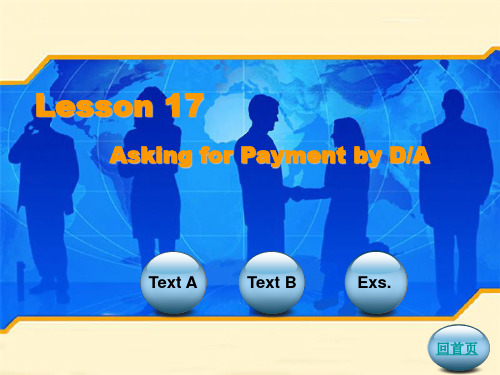
suggestion. 接受我们的建议是没有任何风险的。
• risk vt. 冒……的风险 We won’t risk losing our customer by sending
defective goods. 我们不会冒发送缺陷商品而失去客户的风险。
Exercise I
1
C
2
A
3
A
4
A
5
B
LESSON 17
Text study (Part B)
• We have received your letter of May 11 and noted your kind intention of pushing the sales of our porcelain in your country.
• While we appreciate your trial order for our goods, we regret that we are unable to consider your request for payment under D/A terms as we generally ask for payment by Letter of Credit.
Lesson 17
Asking for Payment by D/A
Text A
国际商务英语模拟试题带答案
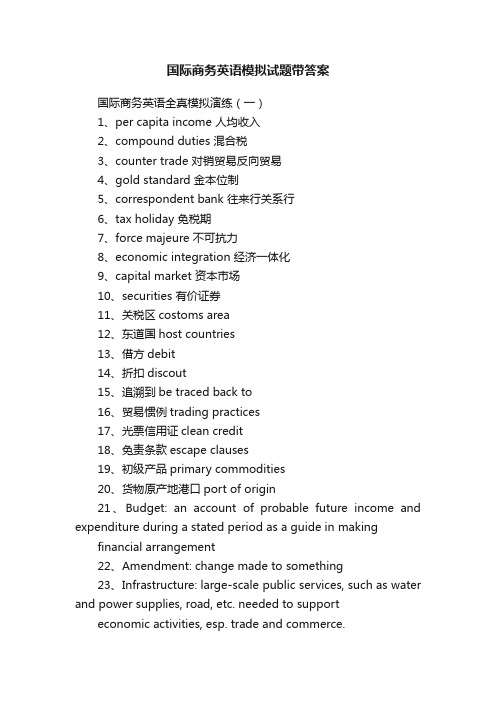
国际商务英语模拟试题带答案国际商务英语全真模拟演练(一)1、per capita income 人均收入2、compound duties 混合税3、counter trade 对销贸易反向贸易4、gold standard 金本位制5、correspondent bank 往来行关系行6、tax holiday 免税期7、force majeure 不可抗力8、economic integration 经济一体化9、capital market 资本市场10、securities 有价证券11、关税区costoms area12、东道国host countries13、借方debit14、折扣discout15、追溯到be traced back to16、贸易惯例trading practices17、光票信用证clean credit18、免责条款escape clauses19、初级产品primary commodities20、货物原产地港口port of origin21、Budget: an account of probable future income and expenditure during a stated period as a guide in making financial arrangement22、Amendment: change made to something23、Infrastructure: large-scale public services, such as water and power supplies, road, etc. needed to supporteconomic activities, esp. trade and commerce.24、Abundant: plentiful, more than enough.25、Discrepancy: difference; absence of agreement.26、Remittance: money sent by post27、After sight: after presentation of draft28、Expertise: expert skill or knowledge29、Clout: influence30、Contract proper: the main body of a contract.31、World company: a world company is a multinational company whose national identity has been blurred.32、Incoterms; incoterms are a set of international rules for the interpretation of trade terms.33、Contract: a contract is an agreement which sets ofrth binding obligations of the relevant parties.34、Bill of exchange: the bill of exchange is an unconditional order to a bank or a customer to pay a sum of money to someone on demand or at a fixed time in the future.35、FDI: foreign direct investments.International investment can be classified into two categories: portfolio investment and foreign direct investment. portfolio investment is a kind of investment in which the investor does not exercise any managerial control. The investor either holds foreign bonds or other non-equity securities which do not confer ownership rights or the investor holds stock shares (or other equities)in a foreign company in an amount too small to exercise any managerial control. In contrast foreign direct investment is a long-term equity investment in a foreign company that gives the investor managerial control over that company, foreign derect investments are mainly carried out by multinational corporations . surveys and cases studies indicate that their common motives for making foreign directinvestments are based on strategic considerations involving market penetration ,technological know-how, reducing costs of distribution and transportation, labor, raw materials and political factors.46、what does international business refer to ?International business refers to transaction between parties from different countries.47、describe briefly the characteristics of MNEs.Firstly, they are enormous in size. Secondly, they have wide geographical spread. Thirdly, another characteristic of MNEs is their longevity and rapid growth.48、what are the factors that decide the types of documents required for a particular transaction?Different documents are required for different transactions; thus the following factors must be take into consideration: the nature of the deal, the term of delivery, the type of commodity, stipulations of credit, regulations and practices in different countries.49、what is the Special Drawing Right? How was it created?The special drawing right is sometimes called paper gold and used to settle official transactions at the IMF.With the increase of foreign dollar holdings to finance trade expansion, the faith of dollar holders decreased in the ability of the United States to redeem the dollar for gold. To reduce the demand for the dollar as a reserve currency, the Special Drawing Right was created.50、the term Triad refers to the three richest regions of the world, the United States, the European Union and Japan that offer the most important business opportunities, any international enterprise must bear Triad in mind if they want to e successful inthe increasingly competitive world market.术语TRIAD 是指世界上最富有的三大市场:美国、欧盟和日本。
- 1、下载文档前请自行甄别文档内容的完整性,平台不提供额外的编辑、内容补充、找答案等附加服务。
- 2、"仅部分预览"的文档,不可在线预览部分如存在完整性等问题,可反馈申请退款(可完整预览的文档不适用该条件!)。
- 3、如文档侵犯您的权益,请联系客服反馈,我们会尽快为您处理(人工客服工作时间:9:00-18:30)。
1)出口货物索赔
属于出口货物遭受 损失,对方(进口方) 向保险单所载明的国外 理赔代理人提出索赔申 请。中国人民保险公司 在世界各主要港口和城 市,均设有委托国外检 验代理人和理赔代理人 两种机构,前者负责检 验货物损失。
Model Practice Business Tips Emergency & Precaution Pattern & Useful Sentences
Model Practice Business Tips Emergency & Precaution Pattern & Useful Sentences
Exercises
BACK
国《际国商际务商 英务语英模语拟模 实拟训实训》
Unit Seventeen Claim
BUSINESS TIPS
1.索赔函四要素 2.索赔的原则 3.索赔单据 4.索赔程序
就要准备下列各项必 要的索赔单证:
清单。如商业发票上是 F0B价格而按CIF价格索 赔,经承运人要求,还应 提供运费及保险收据。
Model Practice Business Tips Emergency & Precaution Pattern & Useful Sentences
Exercises
Exercises
BACK
国《际国商际务商 英务语英模语拟模 实拟训实训》
Unit Seventeen Claim
BUSINESS TIPS
1.索赔函四要素 2.索赔的原则 3.索赔单据
6)费用单证 向船方索赔修理、整
理货物的费用的证明文件。
若决定对外索赔,
就要准备下列各项必 要的索赔单证:
Model Practice Business Tips Emergency & Precaution Pattern & Useful Sentences
Model Practice Business Tips Emergency & Precaution Pattern & Useful Sentences
Exercises
BACK
国《际国商际务商 英务语英模语拟模 实拟训实训》
Unit Seventeen Claim
BUSINESS TIPS
1.索赔函四要素
BUSINESS TIPS
1.索赔函四要素
1) 摆明事实
摆明事实即在索赔函中说明货物或单据已收 到,作为索赔的背景,以便对方理解。
Model Practice Business Tips Emergency & Precaution Pattern & Useful Sentences
Exercises
Exercises
BACK
国《际国商际务商 英务语英模语拟模 实拟训实训》
Unit Seventeen Claim
BUSINESS TIPS
1.索赔函四要素 2.索赔的原则
2) 有根有据
处理对外索赔案件,要进行深入细致地调查 研究,掌握货损货差的有效证件。根据运输合同 的规定,尊重有关的国际惯例,做到有根有据, 这是处理货物索赔的基础。
提出索赔申请。
保险索赔可分为以下 两种情况:
Model Practice Business Tips Emergency & Precaution Pattern & Useful Sentences
Exercises
BACK
国《际国商际务商 英务语英模语拟模 实拟训实训》
Unit Seventeen Claim
【背景提示】提货之后,买方发现有两箱货物有 误,要求调换货物。
Model Practice Business Tips Emergency & Precaution Pattern & Useful Sentences
Exercises
BACK
国《际国商际务商 英务语英模语拟模 实拟训实训》
Unit Seventeen Claim
Model Practice Business Tips Emergency & Precaution Pattern & Useful Sentences
Exercises
BACK
国《际国商际务商 英务语英模语拟模 实拟训实训》
Unit Seventeen Claim
BUSINESS TIPS
1.索赔函四要素 2.索赔的原则
Exercises
BACK
国《际国商际务商 英务语英模语拟模 实拟训实训》
Unit Seventeen Claim
BUSINESS TIPS
1.索赔函四要素
3) 提出解决办法
索赔方应根据自己的想法提出具体而有建设 性的建议。提出的要求必须切实可行,同时要利 用对方的正义感和他们想继续合作的愿望来达到 自己的目的。语气要温和有礼,但态度要坚决。
Exercises
BACK
国《际国商际务商 英务语英模语拟模 实拟训实训》
Unit Seventeen Claim
BUSINESS TIPS
1.索赔函四要素 2.索赔的原则
4) 区别对待
根据我国的对外政策,考虑船东的政治态度 和业务上与我合作的情况,做到有理、有利、有 节。对不同对象采用不同方式,区别对待,处理 索赔案件。
4)提单 正本或影印本。
若决定对外索赔,
就要准备下列各项必 要的索赔单证:
Model Practice Business Tips Emergency & Precaution Pattern & Useful Sentences
Exercises
BACK
国《际国商际务商 英务语英模语拟模 实拟训实训》
BACK
国《际国商际务商 英务语英模语拟模 实拟训实训》
Unit Seventeen Claim
BUSINESS TIPS
1.索赔函四要素
2) 提出索赔
简明扼要摆出索赔的原因,并提出索赔依据, 如:随函附寄订单、装箱单、商业发票、调查报 告等复印件,必要时可附寄照片。
Model Practice Business Tips Emergency & Precaution Pattern & Useful Sentences
Exercises
BACK
国《际国商际务商 英务语英模语拟模 实拟训实训》
Unit Seventeen Claim
BUSINESS TIPS
1.索
2.索赔的原则
成损失的原因,确定对外
3.索赔单据
索赔的比例,按CIF价格 计算损失金额,编制索赔
若决定对外索赔,
Unit Seventeen Claim
BUSINESS TIPS
1.索赔函四要素 2.索赔的原则 3.索赔单据
5)商业发票 必要时应加附装箱单
或磅码单。
若决定对外索赔,
就要准备下列各项必 要的索赔单证:
Model Practice Business Tips Emergency & Precaution Pattern & Useful Sentences
BUSINESS TIPS
2)进口货物索赔
1.索赔函四要素
属于进口货物遭受损失, 我国进口方向保险公司提出
2.索赔的原则
索赔申请。当进口货物运抵
3.索赔单据
我国港口、机场或内地后发 现有残损短缺时,应立即通
4.索赔程序
知当地保险公司,会同当地
国家商检部门联合进行检验。
提出索赔申请。 若经确定属于保险责任范围
国《际国商际务商 英务语英模语拟模 实拟训实训》
Unit Seventeen Claim
MODEL PRACTICE
【BUSINESS SITUATION】 Having taken delivery of the goods, Alfred White found two cases containing wrong goods. Therefore, he is writing to ask for replacement.
Model Practice Business Tips Emergency & Precaution Pattern & Useful Sentences
Exercises
BACK
国《际国商际务商 英务语英模语拟模 实拟训实训》
Unit Seventeen Claim
BUSINESS TIPS
1.索赔函四要素 2.索赔的原则 3.索赔单据
3) 合情合理
在处理复杂案件时,根据造成损失的各种因 素,合理地确定承运人应承担的责任。从有利案 件的及时解决出发,必要时可作些让步,做到合 情合理。
Model Practice Business Tips Emergency & Precaution Pattern & Useful Sentences
Exercises
BACK
国《际国商际务商 英务语英模语拟模 实拟训实训》
Unit Seventeen Claim
BUSINESS TIPS
1.索赔函四要素 2.索赔的原则 1) 实事求是
按照事故的实际情况,分析造成事故的原因, 确定损失的程度或准确数量。对应该索赔的货物, 必须坚持索赔。
Model Practice Business Tips Emergency & Precaution Pattern & Useful Sentences
